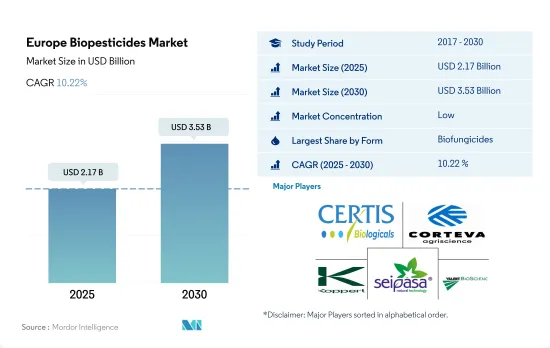Need help finding what you are looking for?
Contact Us
PUBLISHER: Mordor Intelligence | PRODUCT CODE: 1685867

PUBLISHER: Mordor Intelligence | PRODUCT CODE: 1685867
Europe Biopesticides - Market Share Analysis, Industry Trends & Statistics, Growth Forecasts (2025 - 2030)
PUBLISHED:
PAGES: 171 Pages
DELIVERY TIME: 2-3 business days
SELECT AN OPTION
The Europe Biopesticides Market size is estimated at 2.17 billion USD in 2025, and is expected to reach 3.53 billion USD by 2030, growing at a CAGR of 10.22% during the forecast period (2025-2030).

- Biopesticides are naturally occurring substances or agents derived from animals, plants, insects, and microorganisms, including bacteria and fungi, which are used to manage agricultural pests and infections. In 2022, the European biopesticides market accounted for about 77.9% of the global crop protection market by value.
- The European biopesticides market value increased by about 31.2%, between 2017 and 2022. The market value is anticipated to increase by about 77.9% and reach USD 3.20 billion by the end of the forecast period. While the prevalence of chemical or synthetic pesticides in crop protection is continuing, human and animal health concerns are playing key roles in driving the growth of biopesticides.
- The biopesticides market is dominated by field crops, which accounted for a 78.6% share, valued at about USD 1.29 billion in 2022. The dominance of field crops is mainly due to its large cultivation area in the region, which accounted for about 81.2% of the total organic crop cultivation area in 2022.
- Biofungicides dominate the European biopesticides market. The segment held a market share of 59.3% in 2022, valued at USD 971.3 million.
- The European Green Deal set the challenging goal of reducing the use and risk of chemical pesticides by 50% in 2030. IPM strategies are likely to be used, which are based on a holistic view of agroecosystems, with the goal of developing pest- and disease-resistant cropping systems that primarily employ non-chemical pest management measures. They also promote Integrated Pest Management (IPM) tools, which assist farmers in finding the required solutions. Such factors and the growing trend of farmers transitioning to organic agriculture are expected to drive the European biopesticides market between 2023 and 2029
- The European biopesticides market may grow in the coming years, owing to a shift toward sustainable agricultural practices and increasing demand for organic products. France dominated the market with a 19.1% share in 2022, as French farmers used biopesticides to reduce reliance on chemical inputs in agriculture, aligning with the country's public policy objectives.
- Italy is the second-largest market for biopesticides in Europe. It is projected to grow by 75.2%, with a CAGR of 9.8% between 2023 and 2029. Recently, the European Commission has endorsed four legal acts that simplify the approval and authorization process of biological plant protection products containing microorganisms, which are expected to provide farmers with tools to substitute chemical plant protection products and support the objectives of the Farm-to-Fork Strategy.
- Organic farming is a key sector of EU agriculture, with almost 330,000 organic farmers in the European Union in 2019 and a 20% share of the farming area in the Member States. The Farm-to-Fork Strategy aims to increase the total farmland under organic farming in the European Union to at least 25% by 2030, providing opportunities for sustainable alternatives to control plant pests.
- The rising product launches and government support for the use of biopesticides are expected to significantly impact the market in the coming years, with the potential for continued growth and innovation in sustainable agricultural solutions. As the market evolves, industry players must keep up with changing consumer preferences and regulatory requirements and invest in R&D to meet the growing demand for sustainable agricultural solutions.
Europe Biopesticides Market Trends
European green deal is majorly contributing for increasing organic cultivation across the region
Growing demand and rising the per capita spending on organic products in the region
Europe Biopesticides Industry Overview
Additional Benefits:
Product Code: 48764
TABLE OF CONTENTS
1 EXECUTIVE SUMMARY & KEY FINDINGS
2 REPORT OFFERS
3 INTRODUCTION
- 3.1 Study Assumptions & Market Definition
- 3.2 Scope of the Study
- 3.3 Research Methodology
4 KEY INDUSTRY TRENDS
- 4.1 Area Under Organic Cultivation
- 4.2 Per Capita Spending On Organic Products
- 4.3 Regulatory Framework
5 MARKET SEGMENTATION (includes market size in Value in USD and Volume, Forecasts up to 2030 and analysis of growth prospects)
6 COMPETITIVE LANDSCAPE
7 KEY STRATEGIC QUESTIONS FOR AGRICULTURAL BIOLOGICALS CEOS
8 APPENDIX
Have a question?


SELECT AN OPTION
Have a question?


Questions? Please give us a call or visit the contact form.
